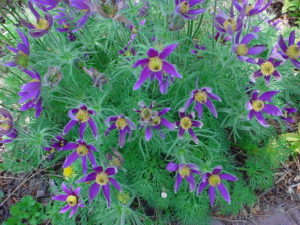
Variegated Solomon’s seal is a well-behaved, shade-loving plant.
Photo provided by Rosie Lerner, Purdue Extension.
Plants differ in their adaptability to different growing conditions. Sunshine is one of the most significant factors. We often think of light as being either sunny or shady, but, in fact, there are many “shades” of light in between. Your garden may experience light shade, such as that filtered through an overhanging tree; dense shade, such as that found in woodlands; or intermittent shade from an object, such as a building that blocks the sun for only a portion of the day.
Some sites vary in their light exposure, depending on the season. Wooded areas usually have much more sunlight in winter and early spring when the trees are bare than in spring and summer when foliage blocks the light.
Most horticultural plants perform best in full sun but may be able to tolerate semi-shady conditions. Trimming nearby trees and shrubs may help increase the light. Some plants may produce lots of lush foliage in the shade but produce few or no flowers unless adequate sunlight is available. Thankfully, a number of plants thrive in the shade.
You don’t have to live in the tropics to have a stunning foliage display in your shade garden. Midwest gardeners have a wonderful foliage palette that can fill in areas among other perennials, or even star as the focal point. Some perennials have both attractive flowers and foliage, so they provide season-long interest.
Another important factor to consider is soil moisture and drainage. Plants vary in their requirement/tolerance of drought, wet feet and soil quality. Soils can be wet with good drainage or be wet because of poor drainage; the latter is a more difficult situation. It’s wise to address the drainage issue before planting.
The following lists suggest a selection of plants for part to full shade, but be sure to do the rest of your homework in matching species to site conditions. Note that some entries appear under both flowers and foliage lists.
Perennial Flowers
Aquilegia sp. (columbine)
Astilbe x arendsii (Astilbe x arendsii)
Bergenia cordifolia (heartleaf bergenia, pigsqueak)
Brunnera macrophylla (Siberian bugloss)
Darmera peltata (umbrella plant)
Hosta sp. (hosta, plantain lily)
Lamium maculatum (spotted deadnettle)
Lobelia cardinalis (cardinal flower)
Lobelia siphilitica (blue cardinal flower)
Mertensia virginica (Virginia bluebells)
Polemonium caeruleum (Jacob’s ladder)
Polygonatum odoratum ‘Variegatum’ (variegated Solomon’s seal)
Primula sp. (primrose)
Pulmonaria saccharata (lungwort, Bethlehem sage)
Pulsatilla vulgaris (Pulsatilla vulgaris)
Rodgersia aesculifolia (Rodgersia)
Sanguinaria canadensis (bloodroot)
Thalictrum aquilegiifolium (meadow rue)
Viola sp. (violets)
Perennials Grown Primarily for Foliage
Asarum canadense (wild ginger)
Athyrium filix-femina (common lady fern)
Athyrium niponicum var. Pictum (Japanese painted fern)
Brunnera macrophylla (Siberian bugloss)
Darmera peltata (umbrella plant)
Hakonechloa macra ‘Aureola’ (Japanese forest grass)
Hosta sp. (hosta, plantain lily)
Lamium maculatum (spotted deadnettle)
Matteuccia struthiopteris (ostrich fern)
Osmundastrum cinnamomeum (cinnamon fern)
Polygonatum odoratum ‘Variegatum’ (variegated Solomon’s seal)
Polystichum sp. (Christmas and Holly ferns)
Pulmonaria saccharata (lungwort)
Rodgersia aesculifolia (Rodgersia)

Pasque flower performs well with morning sun and afternoon shade.
Photo provided by Rosie Lerner, Purdue Extension.